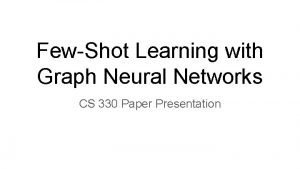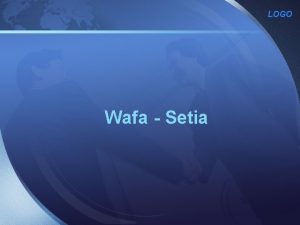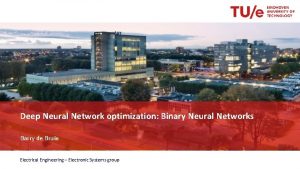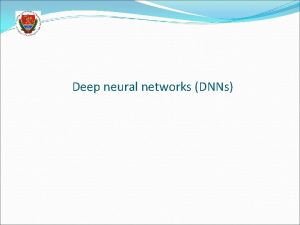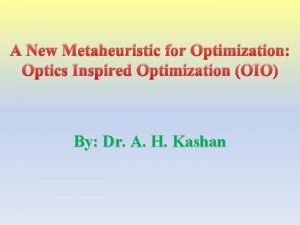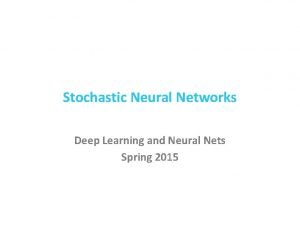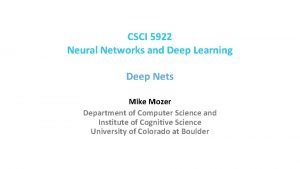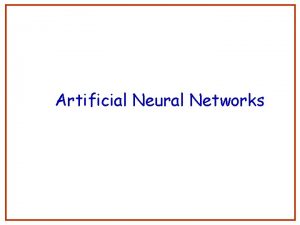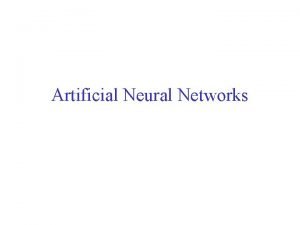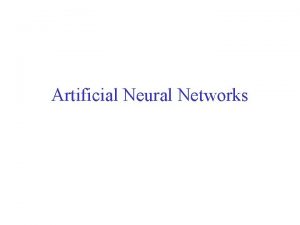LOGO Deep Learning Neural Networks with Metaheuristic Optimization















- Slides: 15

LOGO Deep Learning Neural Networks with Metaheuristic Optimization Algorithms for Groundwater Contamination Vulnerability Mapping in Miryang Aquifer, South Korea Hussam Eldin Elzain · Sang Yong Chung Venkatramanan Senapathi · Kye-Hun Park Pukyong National University, Korea

6/4/2021 Research Scope v Assessment of groundwater contamination vulnerability v Using Deep learning neural networks: Artificial Neural Fuzzy Logic Inference System (ANFIS) v Combined with Genetic Algorithm (GA) and Particle Swarm Optimization (PSO) v Input data: DRASTIC 7 Factors + Landuse v Target (output) data: 95 NO 3 -N concentrations v Study area: Miryang City, Korea (South) 2 Groundwater Environment Lab. , PKNU, Korea

6/4/2021 Study Area (a) (b) (c) Fig. 1. (a) Location map, (b) Sample points, (c) Geological map. 3 Groundwater Environment Lab. , PKNU, Korea

6/4/2021 Flow Chart of VI Assessment 4 Groundwater Environment Lab. , PKNU, Korea

6/4/2021 Artificial Neural Fuzzy Logic Inference System (ANFIS) 5 Groundwater Environment Lab. , PKNU, Korea

6/4/2021 Evaluation of vulnerability factors using Pearson technique and collinearity statistics DRASTIC Factors Predictive Power Depth to water Collinearity Statistics Tolerance VIF 0. 551 0. 512 1. 951 Recharge 0. 454 0. 574 1. 739 Aquifer media 0. 566 0. 374 2. 672 Soil media 0. 460 0. 534 1. 872 Topographic slope 0. 338 0. 619 1. 389 Vadose zone 0. 595 0. 376 2. 657 Conductivity 0. 749 0. 506 1. 975 Land use 0. 671 0. 584 1. 710 6 Groundwater Environment Lab. , PKNU, Korea

6/4/2021 Thematic Maps of DRASTIC Factors (a) Depth to water (b) Recharge rate (c) Aquifer media (d) Soil media (a) (b) (d) (c) 7 Groundwater Environment Lab. , PKNU, Korea

6/4/2021 Thematic Maps of DRASTIC Factors (e)Topographic slope (f)Impact to vadose zone (g)Hydraulic Conductivity(h)Landuse (e) (e) (g) (f) (h) 8 Groundwater Environment Lab. , PKNU, Korea

6/4/2021 Graphical representations of training and testing performances for (a, d) Original ANFIS, (b, e) ANFIS-GA, and (c, f) ANFIS-PSO. (a) (d) (b) (c) (e) (f) 9 Groundwater Environment Lab. , PKNU, Korea

6/4/2021 Statistical performance of ANFIS models Statistical Factors Original ANFIS-GA ANFIS-PSO Training Testing MAE 0. 190 0. 637 0. 103 0. 333 0. 100 0. 318 RMSE 0. 338 0. 890 0. 319 0. 491 0. 234 0. 478 0. 931 0. 493 0. 935 0. 717 0. 971 0. 851 10 Groundwater Environment Lab. , PKNU, Korea

6/4/2021 Validation of Models (a) AUC validation curves of ANFIS models for (a) training and (b) testing results (b) Variation curves of objective function values produced from ANFIS-MOA models. 11 Groundwater Environment Lab. , PKNU, Korea

6/4/2021 Groundwater contamination (nitrate) vulnerability maps (a) Original NO 3 -N, (b) Original ANFIS, (c) ANFIS-GA, (d) ANFIS-PSO. (a) (c) (b) (d) 12 Groundwater Environment Lab. , PKNU, Korea

6/4/2021 Conclusions (1) v This study used adaptive neuro-fuzzy inference system (ANFIS) combined with metaheuristic optimization algorithms (MOA) of genetic algorithm (GA) and particle swarm optimization (PSO) to assess groundwater contamination (NO 3 -N) vulnerability in Miryang, City, South Korea. v 8 parameters (Depth to water, net Recharge, Aquifer type, Soil media, Topographic slope, Impact to vadose zone, hydraulic Conductivity and Landuse) were classified into numerical ratings to be used as input variables of ANFIS-MOA models. v ANFIS, ANFIS-PSO and ANFIS-GA used 95 measured NO 3 N concentrations from monitoring wells for the training (70% data) and testing (30% data) purposes. 13 Groundwater Environment Lab. , PKNU, Korea

6/4/2021 Conclusions (2) v The model performance was verified by the statistical data of MAE, RMSE and correlation coefficient, and it was also verified by ROC/AUC curve. ANFIS-PSO showed the highest performance in the testing results (MAE= 0. 318; RMSE=0. 478; R=0. 851; AUC=0. 893) in comparison with ANFIS-GA (MAE=0. 333; RMSE=0. 491; R=0. 717; AUC=0. 821) and Original ANFIS (MAE=0. 637; RMSE=0. 890; R=0493; AUC=0. 643). v Integrated studies of statistical errors, objective function values, ROC/AUC curve and groundwater contamination (NO 3 -N) vulnerability maps revealed that ANFIS-PSO model was the most superior in predicting groundwater contamination vulnerability in Miryang City of South Korea. 14 Groundwater Environment Lab. , PKNU, Korea

LOGO
 Mippers
Mippers Deep forest: towards an alternative to deep neural networks
Deep forest: towards an alternative to deep neural networks Tabu search tsp
Tabu search tsp Efficient processing of deep neural networks
Efficient processing of deep neural networks Neural networks and learning machines 3rd edition
Neural networks and learning machines 3rd edition Few shot learning with graph neural networks
Few shot learning with graph neural networks Neural networks and learning machines
Neural networks and learning machines Cmu machine learning
Cmu machine learning Deep learning approach and surface learning approach
Deep learning approach and surface learning approach Visualizing and understanding convolutional neural networks
Visualizing and understanding convolutional neural networks Vc dimension neural network
Vc dimension neural network Lateralization
Lateralization Audio super resolution using neural networks
Audio super resolution using neural networks Convolutional neural networks for visual recognition
Convolutional neural networks for visual recognition Leon gatys
Leon gatys Convolutional neural network presentation
Convolutional neural network presentation





